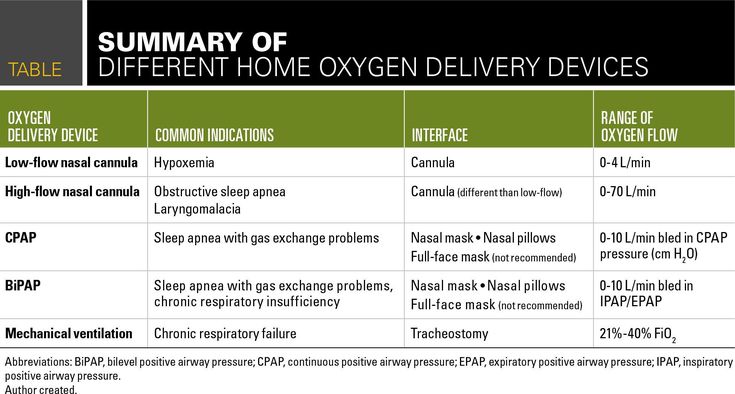Oxygen Flow Rate Of Nasal Cannula
High flow nasal prong therapy (hfnp) see the hfnp nursing clinical guideline for more information. • the device consists of a large bore nasal cannula that attaches to corrugated tubing (circuit) to a heated humidifier with an oxygen source.

Pin On Products
Table 2 nasal cannula flow rate recommendations.

Oxygen flow rate of nasal cannula. Flow rates of up to 6 litres can be given but this will often cause nasal dryness and can be uncomfortable for. Of the remaining 32 patients, 81% (n=26) had an actual initial flow rate within 1 l of the target flow rate; 2 a nasal cannula can deliver 22% to 60% oxygen with appropriate oxygen flow rates of 0.5 to 2 l/minute.
Flow rates of up to 6 liters can be administered, but this will often cause nasal dryness and can be uncomfortable for patients. Nasal cannula is a device that helps deliver oxygen from an oxygen supply source (i.e. If the inspiratory flow rate of the patient is greater than what is being provided by the cannula, the patient will entrain room air into the lungs.
Below is an image of the fisher and paykel optiflow nasal cannula junior range for airvo 2. A nasal cannula is generally used wherever small amounts of supplemental oxygen are required, without rigid control of respiration, such as in oxygen therapy. These patients were evaluated for changes in fraction of inspired oxygen (fio 2), ph, and pco 2 values after 24 hours.
Nasal cannula oxygen percentage chart above shows the oxygen flow rate from 1 to 6 where 1 l/min delivers fio2 as 28 % and 6 l/min delivers an oxygen concentration of 44%. Oxygen tank, portable oxygen concentrator) to an individual needing oxygen. • a flow rate of 15 to 60 l/minute.
A nasal cannula is generally used wherever small amounts of supplemental oxygen are required, without rigid control of respiration, such as in oxygen therapy. The lightweight tube has two prongs that fit into the nostrils, wraps behind the ears and attaches the oxygen supply source (i.e. Flow rates of 1 to 4 liters per minute are used with nasal cannulas, which equates to a concentration of approximately 24 to 40% oxygen.
Size flow rate all premature cannulas ≤3 lpm all neonatal cannulas ≤3 lpm all infant ≤cannulas 3 lpm all intermediate infant/toddler cannulas ≤ 3 lpm pediatric cannulas ≤ 6 lpm pediatric high flow cannulas ≤ 15 lpm adult conventional cannulas ≤ 6 years adult micro cannulas ≤ 3 lpm adult quit cannulas ≤ 8 lpm All settings are controlled independently, allowing for greater confidence in the delivery of supplemental oxygen as well as better outcomes when used. High flow nasal cannula • patients who require a higher dose of supplemental oxygen but can't tolerate a mask or when a mask impairs a patient's ability to eat,
One patient could not tolerate the cannula. Most systems provide flow rates up to 5 liters per minute which is approximately 36 to 41% oxygen. The child inspires room air in addition to the supplemental oxygen, and a variable concentration of oxygen is delivered.
But patients with respiratory distress can have much higher peak inspiratory flow rates. The nasal cannula allows breathing through the mouth or nose. This is typically delivered by nasal cannula or prongs.
Flow rates up to 60 liters per minute are delivered to the nasal cannula via a heated circuit. Even during quiet breathing, inspiratory flow rates are approximately 30 liters per minute, which exceeds supplemental oxygen flow ( 3 ). Flow rates of up to 6 litres can be given but this will often cause nasal dryness and can be uncomfortable for.
An oxygen concentrator or a hospital wall).

Hypoxemia Levels Oxygen Saturation Chart Nursing School Humor Respiratory Care Respiratory Therapy

Pin On Nursing School

Pin On Anesthetisia

Pin On Critical Care-senior Year

Oxygen Delivery Deviceswhat To Know Respiratory Therapy Student Pediatric Patients Respiratory Care

Pin By Nacho Redondo Garcia On Anestesia Acute Respiratory Failure Oxygen Flow

Pin On Respiratory Therapy

Normal Values2 Nursing Notes Respiratory Therapy Coronary Arteries

Nasal Cannula Venturi Face Mask Simple Face Mask Non Rebreather Face Mask Emergency Medicine Nursing Information Respiratory Therapy Student

Pin By Gloria Cook On Ems Nursing Notes Vital Signs Nurse

Oxygen Delivery By Device Nasal Cannula Indicated For Low-flow Low- Percentage Suppl Nursing School Prerequisites Nursing School Tips Nursing School Survival

Pin On Fundamentals Of Nursing

Oxygen Administration Pediatric Nursing Nursing Tips Icu Nursing

Oxygen Delivery Deviceswhat To Know Respiratory Therapy Student Pediatric Patients Respiratory Care

Pin On Nursing Stuff

Pin On Rn Stuff

Oxygen Delivery Devices Pediatric Nursing Nursing Tips Icu Nursing

Pin By Azad Mourya On Anaesthesia Simple Face Trachea Concentration

Oxygen Devices Oxygen Nurse Medical